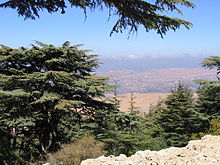Cedar
Cedar (scientific name Cedrus) is a genus of cone-bearing trees in the plant family Pinaceae. They are native to the Mediterranean region.
| Cedar | |
|---|---|

| |
| Lebanon cedar in Al Shouf Cedar Nature Reserve, Barouk, Lebanon | |
| Scientific classification | |
| Kingdom: | Plantae |
| Clade: | Tracheophytes |
| Division: | Pinophyta |
| Class: | Pinopsida |
| Order: | Pinales |
| Family: | Pinaceae |
| Subfamily: | Abietoideae |
| Genus: | Cedrus Trew |
| Species | |
|
See text | |
Cedars are trees up to 30–40 metres (98–131 ft) (occasionally 60 metres (200 ft)) tall. They have spicy-scented wood, thick ridged or square-cracked bark, and broad, level branches. The shoots are of two kinds, long shoots, which form the framework of the branches, and short shoots, which carry most of the leaves. The leaves are evergreen and needle-like, 8–60 mm long, arranged in an open spiral on long shoots, and in dense spiral clusters of 15–45 together on short shoots; they vary from bright grass-green to dark green to strongly glaucous pale blue-green, depending on the thickness of the white wax layer which protects the leaves from drying out. The female seed cones are barrel-shaped, 6–12 cm long and 3–8 cm broad, green at first, then maturing grey-brown, and, as in Abies, disintegrate when mature to release the winged seeds. The seeds are 10–15 mm long, with a 20–30 mm wing; as in Abies, the seeds have 2–3 blisters, containing an unpleasant-tasting resin, thought to be a defence against squirrels eating them. Cones take one year to mature, with pollination in autumn and the seeds maturing the same time a year later. The male pollen cones are slender, egg-shaped, 3–8 cm long, produced in late summer and shedding pollen in autumn.[1]
Naming of species
changeCedar cones have a similar structure to fir cones. For many years in the past, experts thought they were closely related. Modern scientific investigation has shown that they belong to the same family but are not closely related.
There are several types of cedars and experts cannot agree how they are related. Some scientists put them all in one group while others separate them into different groups.[2][3][4][5][6][7][8][9][10][11][12]
These are the names of the different kinds of cedars:
- Deodar or Deodar Cedar, Cedrus deodara (also known as. C. libani subspecies. deodara). Native to Western Himalaya.
- Lebanon Cedar or Cedar of Lebanon, Cedrus libani. Native to the mountains of the Mediterranean region, from Turkey and Lebanon west to Morocco.
- Lebanon Cedar, Cedrus libani subspecies. libani. Native to the mountains of Lebanon, western Syria and south-central Turkey.
- Turkish Cedar Cedrus libani subspecies stenocoma. Native to the mountains of southwest Turkey.
- Cyprus Cedar, Cedrus brevifolia (also known as Cedrus libani subsp. brevifolia or Cedrus libani variety brevifolia). Native to the mountains of Cyprus.
- Atlas Cedar, Cedrus atlantica (also known as Cedrus libani subspecies atlantica). Atlas mountains in Morocco & Algeria.
References
change- ↑ The maturation and dispersal of cedar cones and seeds. International Dendrology Society Yearbook 1993: 43–46.
- ↑ Farjon, A. (1990). Pinaceae. Drawings and Descriptions of the Genera. Koeltz Scientific Books ISBN 3-87429-298-3.
- ↑ Gymnosperm database Cedrus.
- ↑ NCBI Taxonomy Browser Cedrus.
- ↑ Flora of China vol. 4
- ↑ Qiao, C.-Y., Jin-Hua Ran, Yan Li and Xiao-Quan Wang (2007): Phylogeny and Biogeography of Cedrus (Pinaceae) Inferred from Sequences of Seven Paternal Chloroplast and Maternal Mitochondrial DNA Regions. Annals of Botany 100(3):573-580. Available online
- ↑ Farjon, A. (2008). A Natural History of Conifers. Timber Press ISBN 0881928690.
- ↑ Christou, K. A. (1991). The genetic and taxonomic status of Cyprus Cedar, Cedrus brevifolia (Hook.) Henry. Mediterranean Agronomic Institute of Chania, Greece.
- ↑ GRIN Taxonomy for Plants Cedrus Archived 2009-01-20 at the Wayback Machine.
- ↑ Güner, A., Özhatay, N., Ekim, T., & Başer, K. H. C. (ed.). 2000. Flora of Turkey and the East Aegean Islands 11 (Supplement 2): 5–6. Edinburgh University Press. ISBN 0-7486-1409-5
- ↑ Eckenwalder, J. E. (2009). Conifers of the World: The Complete Reference. Timber Press ISBN 0881929743.
- ↑ Sell, P. D. (1990). Some new combinations in the British Flora. Watsonia 18: 92.